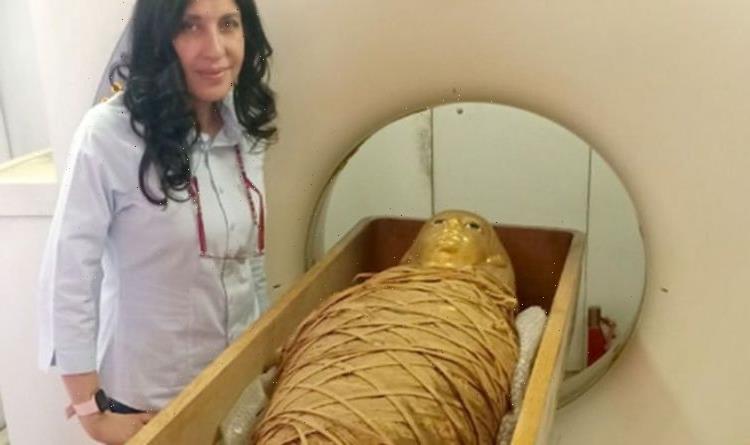Egypt: Hall of Records archive under Sphinx 'breached' says expert
We use your sign-up to provide content in ways you’ve consented to and to improve our understanding of you. This may include adverts from us and 3rd parties based on our understanding. You can unsubscribe at any time. More info
The incredible image was obtained by Dr Sahar Saleem, professor of radiology at the Faculty of Medicine at Cairo University. She is a radiologist of the Egyptian Mummy Project, where she uses medical imaging, in particular CT scans, to study the ancients. This enables her to look through the wrappings, providing more detail than X-rays.
In her recent project, the perfectly wrapped mummified body of the Egyptian Pharaoh Amenhotep I has been seen for the first time in centuries.
It was “digitally unwrapped” by the technology, but the images have not yet been released of what hides under the wrappings.
Dr Saleem has scanned several of the royal mummies, including Hatshepsut, Thutmose III and Seti I, from the Egyptian Museum in Cairo. T
These mummies have been described in her book Scanning the Pharaohs: CT Imaging of the New Kingdom Royal Mummies, which she co-authored with Dr Zahi Hawass.


By using CT scans on the mummy of Tutankhamun, Dr Saleem and Dr Hawass determined that he was around 19 years old when he was mummified.
They also hypothesised that the cause of death was not head trauma, as previously thought, but a knee fracture on a background of malaria.
They also scanned Ramesses III, a pharaoh who was thought to be the victim of a harem conspiracy.
Their work revealed that Ramesses throat was cut and his left toe was cut off, providing supporting evidence that he was likely killed in that conspiracy, as the injuries pointed to there being more than one attacker.
Amenhotep I was the second Pharaoh of the 18th Dynasty of Egypt.

His reign is generally dated from 1526 to 1506 BC.
He is believed to have ruled for about 21 years.
Although his reign is poorly documented, it is possible to piece together a basic history from the available evidence.
His mummy was found in Deir el-Bahri, but was likely originally buried in Dra’ Abu el-Naga’ or KV39 at the Valley of the Kings.
Archaeologists believe his mummy was removed from his tomb to protect him from grave robbers, but its location has never been confirmed.
Egyptologist Chris Naunton hopes they will soon find the tomb.


He said: “The two first rulers of the 18th dynasty, Ahmoses I and Amenhotep I, are both missing.
“We have their mummies, these turned up in caches – at the end of the 20th Dynasty, the tombs were being robbed – so the authorities took all the mummies out of the Valley of the Kings and reburied them again in secret.
“So we know from this and records of tomb inspections that the tomb of Amenhotep I was visited.
“There’s even an ancient description of the location of it, it’s just a little bit difficult to match that to the typography now.
“It talks about a temple – the temple of Amenhotep the guardian – we just don’t know which of the ancient monuments that is.”
Source: Read Full Article
